Ezowm – India’s Indigenous E-Commerce Revolution
The Missing Link in India’s Digital Story
One Nation. Infinite Markets. Every Village, Every Kasba Empowered.
India’s digital transformation has often been narrated through the lens of its metropolitan cities - Bengaluru, Delhi, Mumbai, Hyderabad - where start-ups thrive, multinationals invest, and global technologies penetrate easily. Yet, beneath this urban narrative lies the truer India, the Bharat of villages, kasbas, and small towns, where nearly 65% of the population resides.
This Bharat is not an afterthought. It is the essence of India’s civilization, carrying with it centuries of tradition, self-sufficiency, and cultural pride. And yet, when it comes to digital commerce, this vast geography has been systematically underserved. Global e-commerce platforms, designed for Western urban landscapes, have failed to capture the hyperlocal diversity, economic patterns, linguistic multiplicity, and social realities of Bharat.
In a nation where onion prices may vary drastically between a kasba and a metropolitan market, where cultural festivals dictate consumption, and where dialects change every 50 kilometers, Western e-commerce models simply do not fit. They impose uniformity on diversity, centralization on decentralization, and profit-seeking on community-building.

What Bharat needs is not a copy of Western digital commerce, but an indigenous ecosystem that grows out of its soil, speaks its languages, respects its rhythms, and serves its people. This is the missing link in India’s digital story. And this is the gap that Ezowm, Softa Technologies Limited’s indigenous e-commerce revolution, is designed to fill.
The Rural Bharat Challenge: Where Global Platforms Fail
The world’s largest e-commerce companies pride themselves on scale, logistics, and efficiency. Yet, in the lanes of Nawalgadh in Rajasthan, the by-lanes of Chapra in Bharat, or the marketplaces of Chhindwara in Madhya Pradesh, these global platforms remain distant names rather than lived realities.
Why? Because their models are fundamentally mismatched with Bharat’s ecosystem.
Pricing Mismatch
A kilo of onions in Nawalgadh may cost ₹20, while the same kilo in Jaipur may be priced at ₹28. A global app cannot reflect these realities, because its database is centralized, standardized, and detached from local fluctuations.

Delivery Disconnect
Urban-designed logistics networks, optimized for highways and metros, often fail in narrow rural lanes where local kirana shopkeepers or bicycle delivery agents move with ease and efficiency.

Employment Blindspot
Instead of creating sustainable local jobs in small towns, global e-commerce ironically consolidates employment into massive urban warehouses, further excluding the very youth who desperately seek opportunities in their hometowns.

Cultural Irrelevance
Bharat does not merely buy; Bharat negotiates, exchanges, and builds trust in its markets. Global platforms strip away this human and cultural layer, reducing commerce into sterile, impersonal transactions.

The Core Philosophy of Ezowm
"Commerce must not only sell, it must empower."
Ezowm is not the imitation of a foreign platform. It is the world’s first hyperlocalized, indigenous e-commerce ecosystem, built entirely on Softa’s Hyperlocal Engine and Total Data Safety Technology. Its design is rooted in a philosophy that blends economic pragmatism with social responsibility. Hyperlocal First – Every kasba, every town, and every city has its own Ezowm version. Prices, availability, and delivery mechanisms reflect local realities. This ensures that no farmer, trader, or customer ever feels alienated from the platform.
Employment Generation – Ezowm is not about replacing the kirana shop or the small trader. It is about digitizing them, giving them visibility, and creating new delivery, logistics, and support jobs for rural youth. Digital Self-Reliance – Instead of depending on Western platforms, Ezowm allows Bharat to own its commerce backbone. Profits, opportunities, and data stay within India — strengthening the nation’s march toward Atmanirbhar Bharat.
Secure & Encrypted – Every transaction and user is protected by Softa’s three-layer Total Encryption System, ensuring financial security, data privacy, and digital sovereignty — non-negotiable in today’s AI-driven world.
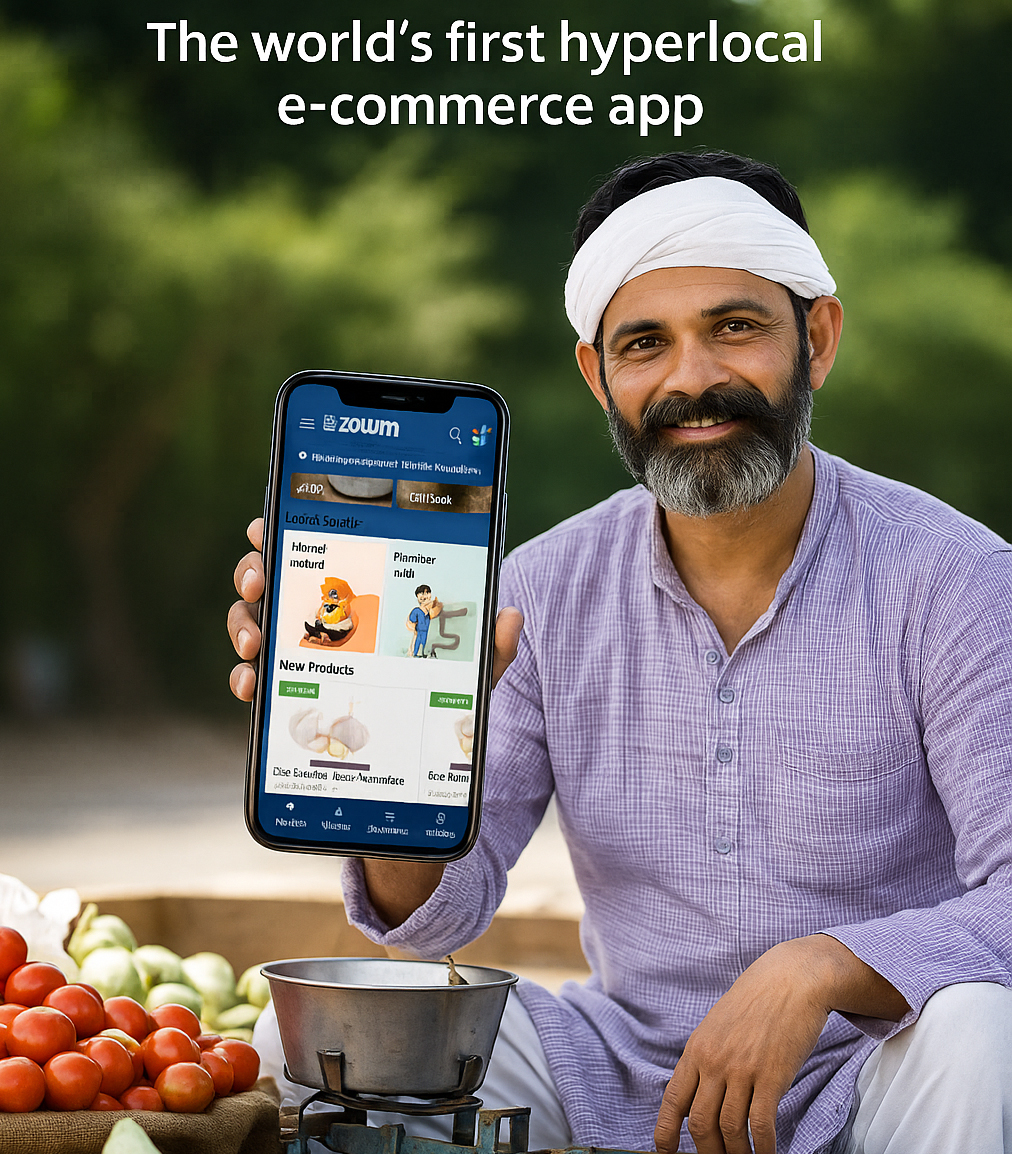
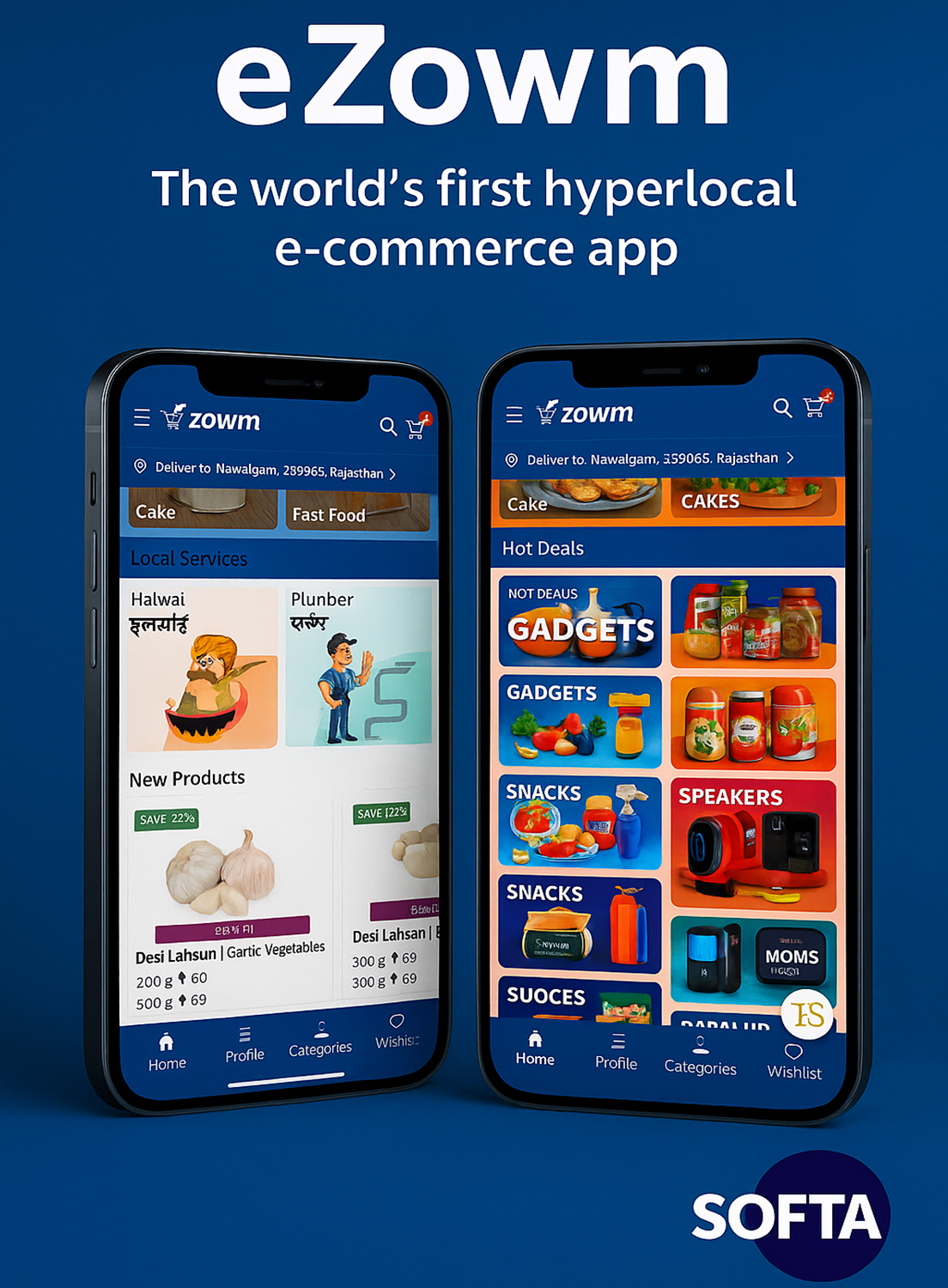
How Ezowm Works: The Nawalgadh Model
Consider Nawalgadh, Rajasthan, as a case study — a small kasba where traditional bazaars have thrived for centuries. Under Ezowm:
- A trader uploads onions for sale. The local Ezowm platform immediately reflects the Nawalgadh price of ₹20/kg.
- A consumer in Nawalgadh sees this rate. A consumer in Jaipur, however, sees the Jaipur mandi price of ₹28/kg.
- The local Ezowm team in Nawalgadh receives the order and coordinates delivery through local delivery agents.
- Payments are fully encrypted, moving securely to the trader’s account without leakages, middlemen, or exploitation.
The result? Ezowm becomes a live digital extension of the physical mandi, preserving the authenticity of hyperlocal trade while offering the convenience of digital ordering.
Bharat’s Digital Bazaar
It is Bharat’s Digital Bazaar - decentralized, rooted, and people-driven.It is commerce that speaks the language of the kasba, empowers local traders, dignifies rural youth with jobs, and ensures that Bharat’s markets evolve on Bharat’s terms — not as replicas of foreign systems, but as living, breathing, indigenous digital ecosystems.
Pilot Projects and Rollout Strategy: Building Bharat’s Digital Future, One Kasba at a Time
Ezowm is not an abstract idea. It is a living, breathing model already being tested in the lanes of Bharat. The strength of any great technological revolution lies not merely in its ambition but in its execution. For Ezowm, execution begins with a carefully crafted pilot-to-scale strategy that is as indigenous and people-driven as the platform itself.
Why Pilot Projects Matter
Global e-commerce platforms, when they launch, often adopt a top-down model — starting in metropolitan hubs and gradually trickling down to smaller towns. Ezowm rejects this approach. Instead, it begins where Bharat lives: in the kasbas and rural towns. The choice is deliberate. If Ezowm can succeed in Nawalgadh, Rajasthan, or Chapra, Bharat, it can succeed anywhere — because these represent the authentic test grounds of Bharat’s economy.By piloting Ezowm in smaller ecosystems, Softa Technologies ensures:
Localization Precision
The hyperlocal engine is tested against real market fluctuations, from vegetable prices to handmade crafts.
Cultural Adaptation
User behavior in Bharat is not uniform. Pilots help Ezowm adapt to negotiation practices, social buying, and seasonal demands.
Employment Framework
Local youth teams are trained to run the system, ensuring that every kasba creates its own self-sustaining workforce.
The Nawalgadh Experiment: Proof of Concept
In Nawalgadh, Rajasthan, Ezowm was launched as a testbed for what a hyperlocal e-commerce revolution could look like. The results were beyond expectation.
Onion prices, varying between ₹20 and ₹28 across kasbas and cities, were accurately reflected in real-time. Farmers and traders reported faster turnaround for sales, with payments securely credited through encrypted systems. Local youth, acting as delivery agents, created a new micro-economy, earning daily wages through the platform. Most importantly, community trust grew rapidly. Unlike foreign platforms, Ezowm was seen as “our own” — a marketplace built for Bharat, by Bharat.
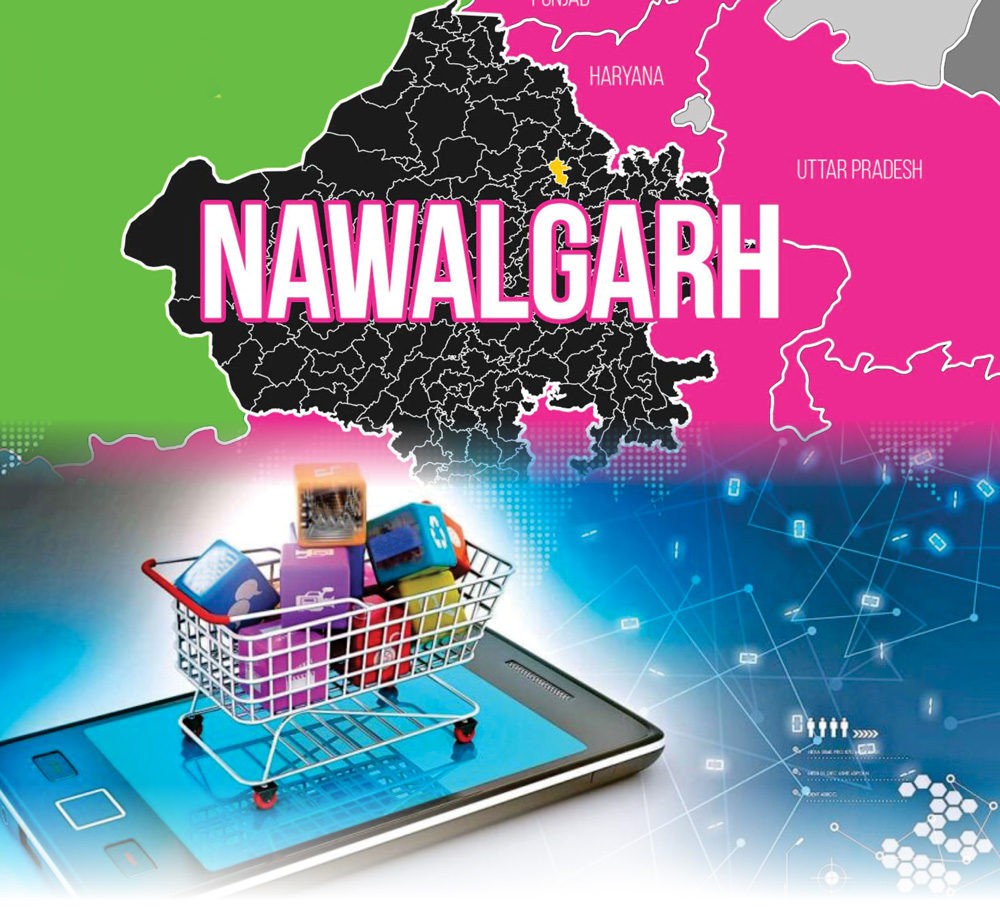
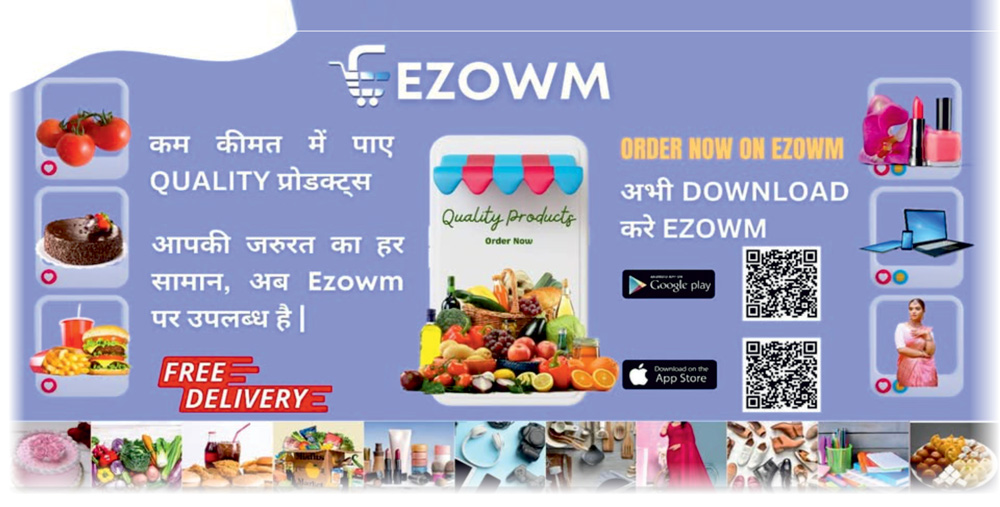
Phased Rollout Plan
Softa Technologies has designed a phased roadmap for Ezowm’s expansion:
Phase I (2026)
Rollout in 20–30 kasbas across Rajasthan, Bharat, Jharkhand, and Madhya Pradesh. These regions were selected due to their high agricultural activity, strong MSME base, and eager youth population.

Phase II (2028–2030)
Expansion to 200+ kasbas and tier-3 towns. At this stage, Ezowm will introduce more specialized categories, including local handicrafts, agro-products, and region-specific textiles.

Phase III (2030–2035)
Integration into every tier-2 city of India. By then, Ezowm will not just be an e-commerce platform but a digital governance and trade ecosystem, connecting farmers, artisans, consumers, and local administrations.

Phase IV (2047)
The centenary of India’s independence. Our vision is to be operational in every kasba, town and city of Bharat, empowering tens of millions of youth with local employment and generating trillions of rupees in economic output.

Pilot Learnings That Define the Rollout
- Trust is the foundation. People embrace platforms that they feel are theirs. Ezowm’s Indian identity is its greatest strength.
- Simplicity wins. Rural Bharat doesn’t want complexity. The platform must be intuitive enough for a farmer or a small shopkeeper with minimal digital literacy.
- Employment is non-negotiable. Any technology that replaces humans will not be accepted. Ezowm thrives because it creates jobs, not eliminates them.
- A Revolution in Rollout Philosophy
- Unlike global tech platforms that chase only scale and profits, Ezowm’s rollout strategy is patient, localized, and sustainable. It respects Bharat’s cultural rhythms, its economic pace, and its social fabric.
Every pilot is not just a test; it is a classroom. Nawalgadh and the other first-phase kasbas taught us:
As Softa’s Founder & CEO Sunil Kumar Singh often emphasizes:
"If a technology cannot work in the smallest kasba of Bharat, it has no moral right to scale across the nation." Ezowm’s rollout is therefore not a race to the biggest cities but a journey into the heart of Bharat.
Ezowm and Employment Generation: A New Digital Economy for Bharat’s Youth
India’s most urgent challenge is not just GDP growth but sustainable and inclusive employment for its rapidly expanding youth population. Every year, crores of young graduates and school-leavers prepare to enter the workforce, yet the number of formal jobs created remains far below demand. The hard reality is this: no government, and no set of large corporations alone, can generate employment at the scale required.
This is why Softa’s Ezowm is more than a digital commerce platform. It is a national employment creation model, rooted in Bharat’s villages and kasbas, built to create jobs where people actually live — not just in distant metros.
The Core Philosophy: Jobs Where People Live
Global e-commerce platforms centralize their operations in a handful of urban hubs. They create warehouse jobs, call-center roles, or delivery networks that barely penetrate rural India. The result: migration, disconnection from families, and an exodus of rural youth toward crowded cities where opportunities often disappoint. Ezowm turns this paradigm upside down. Its philosophy is simple yet revolutionary:
- Digitize Local Economies – Every kasba has its own Ezowm version. Commerce flows locally, creating localized business ecosystems.
- Local Youth, Local Jobs – The delivery, logistics, customer support, and vendor management for Nawalgadh, for example, is handled by the youth of Nawalgadh itself.
- Empowering MSMEs and Farmers – Instead of replacing them, Ezowm digitizes small shopkeepers, artisans, and farmers — creating new jobs in digital marketing, logistics, and financial services.
Ezowm’s Employment Roadmap
Ezowm’s rollout is designed not only for business scalability but also as a phased job creation movement:
Phase I (2026–2027): Pilot Across 20–30 Kasbas, Jobs Created: 4,000–5,000 direct jobs (delivery, vendor support, logistics). Indirect Jobs: 10,000+ (packaging, transport, local marketing).
Case Example: Nawalgadh, Rajasthan, where testing already shows strong results — small traders digitized, youth employed locally, and rural customers gaining access to modern commerce without losing their cultural roots.
Phase II (2028–2030): Expansion to 200+ Towns & Small Cities, Jobs Created: 40,000+ direct and 100,000+ indirect. Ezowm becomes a visible rural employer brand, empowering rural youth who would otherwise migrate.
Phase III (2030–2040): Nationwide Rural Penetration, Targeting 3,000+ kasbas and towns. Jobs Created: 700,000–1 million direct and indirect. Ezowm transforms into Bharat’s largest decentralized employment ecosystem, rivaling government schemes in reach but driven by sustainable business logic, not subsidies.
Phase IV (2040–2047): Bharat@100 Vision Every village, kasba, and city connected to Ezowm. Jobs Created: Several million across delivery, trade facilitation, customer care, digital infrastructure, and more. Bharat achieves a self-reliant digital commerce economy, owned and operated by its people.
Sunil Kumar Singh’s Vision: A Nation Where Rural Youth Lead the Digital Age
Sunil Kumar Singh, CEO of Softa Technologies Limited, often says:
“India cannot simply import Western e-commerce models. We must create an indigenous model where jobs are not sucked into a few megacities but spread across every kasba, every village. Only then will Bharat’s digital revolution be truly democratic.”
Ezowm reflects this philosophy in action. It ensures that the youth of Nawalgadh work in Nawalgadh, the youth of Chapra in Chapra, and so on. This is not just about jobs; it is about nation-building. By anchoring economic opportunities in rural India, Softa is preventing brain-drain, reducing migration pressures on metros, and restoring pride and dignity to rural families.
Beyond Numbers: A Civilizational Employment Model
Employment in Ezowm is not limited to delivery or logistics. It spans multiple levels:
- Digital Vendor Management – Local youth trained to onboard farmers, artisans, and shopkeepers.
- Customer Engagement – Call and chat support in local languages and dialects.
- Hyperlocal Marketing – Using festivals, fairs, and panchayat networks for digital outreach.
- Value-Added Services – Micro-finance, insurance, and agri-tech services provided through the Ezowm network.
This is why Ezowm is more than commerce. It is Digital Swaraj in practice — jobs created where people live, local economies revived, and Bharat’s youth made the architects of its digital century.
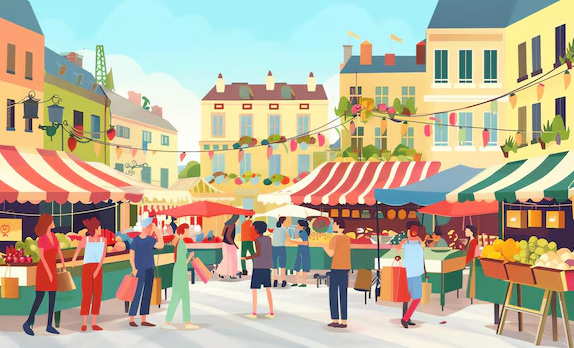
Ezowm – Farmers as Entrepreneurs: Redefining Agriculture in Bharat
For centuries, India’s kisans have been framed as cultivators—producers of raw crops whose economic destiny is set at the mandi gate. Price discovery has been opaque, margins thin, and value capture concentrated away from the farm. In a civilization that once traded botanical wealth across continents, the primary producers became price-takers in their own land.
Ezowm—Softa Technologies Limited (STL)’s indigenous, hyperlocal e-commerce fabric—reverses this logic. Built on STL’s Hyperlocal Engine and Total Data Safety stack, Ezowm recasts the farmer as a digital entrepreneur: a price-setter, brand-owner, quality guarantor, and logistics orchestrator. The platform is not another listing site layered on top of the old system; it is a market architecture that lets agricultural value be created, retained, and reinvested at source.
1. From Cultivator to Enterprise: A Four-Role Evolution
Ezowm’s design enables a farmer to progress from single-role producer to multi-role enterprise:
- Producer → Vendor: The kisan opens a verified Ezowm Farm Store. Inventory is digitized, and pricing can be fixed or dynamic.
- Vendor → Brand: Micro-Branding Toolkit adds farm names, terroir notes, seals, and geo-tags with packaging artwork in local languages.
- Brand → Service: Value rises with pre-sorting, processing, subscriptions, and B2B fulfilment.
- Service → Network: Farms federate into Hyperlocal Producer Networks (HPNs) to share resources, negotiate collectively, and rotate harvests.
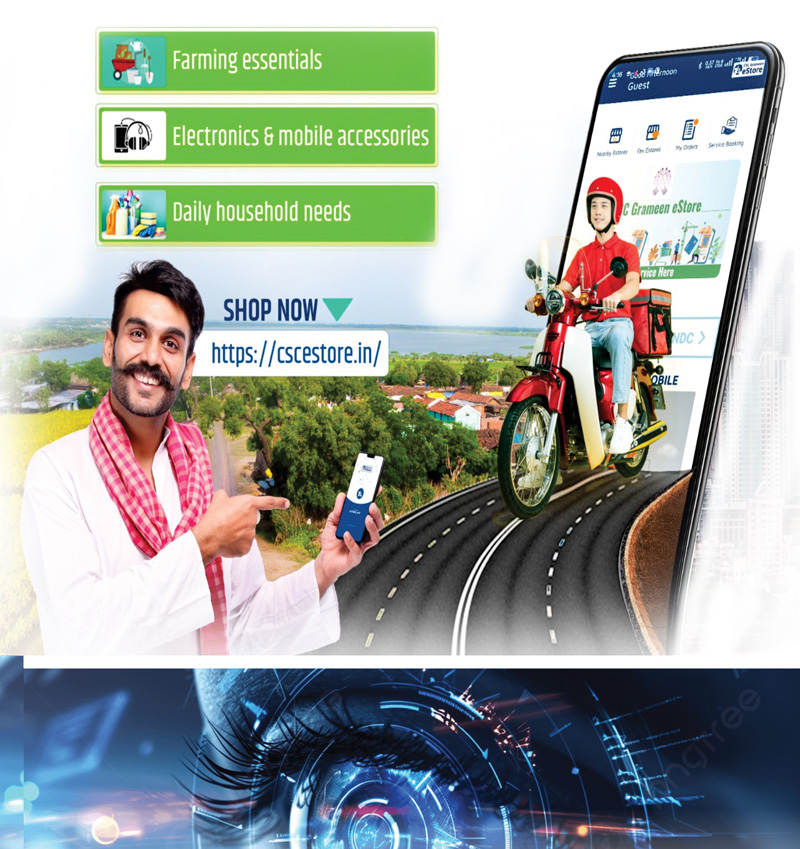
Result: Farmer economics shift from commodity volatility toward brand equity and local network effects.
2) Direct-to-Consumer and Direct-to-Industry: Two Clean Pipes
A) D2C (Households & Retail)
- Hyperlocal pricing with live town-specific supply-demand.
- Proximity advantage preserves freshness and reduces logistics costs.
- Trust with QR-coded provenance and encrypted data.
- Subscriptions for recurring family needs.
B) D2B (Institutions & Processors)
- Digital contracts, SLAs, and volume brackets.
- Specification-matching for food, pharma, and herbal industries.
- Batch traceability from plot to processing node.
Outcome: Farmers monetize quality variance, maximizing returns without waste.
3. Dynamic Pricing, Hedging, and Smart Offers (Without Speculation)
- Smart Floors & Ceilings: Guardrails protect farmers’ minimum price.
- Harvest-Window Incentives: Adders for early/late harvest and festival spikes.
- Micro-Hedges: Forward commitments smooth volatility.
- Quality-Linked Uplifts: Transparent rewards for objective grading.
Risk management remains farmer-friendly and local, avoiding harmful speculative practices.
4. Grading, Trust, and Dispute Resolution That Works
- Objective Grading with devices and photographed samples.
- Third-Party Verifiers at district level resolve disputes.
- Time-Bound Resolutions with partial credits and reverse pickups.
- Reputation Scores for vendors and buyers influence rankings.
5. Logistics that Belong to the Town
- 3-Tier Flow: Farm/Store → Hub → Consumer/Institution.
- Shared cold boxes and right-sized cold storage.
- Local rider networks, including women riders where appropriate.
- Reverse logistics ensure reusables and returns are managed efficiently.
Local ownership of logistics keeps income inside the kasba.
6. Finance that Rewards the Right Behaviors
- Early-Pay Discounts provide farmers liquidity.
- Working-Capital Lines tied to receivables, not land.
- Input Vouchers tied to delivery performance reduce cash-flow stress.
- Insurance Hooks for weather and transit backed by encrypted trails.
7. Training and Onboarding: Assisted, Vernacular, Continuous
- Assisted Onboarding via Ezowm Sahayaks.
- Visual Micro-Lessons in local languages for low-literacy users.
- Harvest Calendars aligned with crops, festivals, and rainfall.
